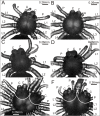Teratological changes in postembryos of Eratigena atrica obtained by the application of alternating temperatures on spider embryos
- PMID: 34131520
- PMCID: PMC8174146
- DOI: 10.7717/peerj.11457
Teratological changes in postembryos of Eratigena atrica obtained by the application of alternating temperatures on spider embryos
Abstract
Spider embryonic development depends on several factors, including temperature. Under optimum thermal conditions embryogenesis proceeds undisturbed and embryo mortality is low. On the other hand, dramatic shifts in incubation temperature may cause a range of developmental defects in embryos. It has been confirmed in numerous laboratory experiments that abrupt temperature changes can be a powerful teratogenic factor. Changes in the external structure are frequently reflected in the internal anatomy, and above all, in the central nervous system. In the present teratological study, by exposing spider embryos to the temperatures of 14 °C and 32 °C, changed every 12 hours for the first 10 days of their development, we obtained 74 postembryos of Eratigena atrica with body deformities such as oligomely, heterosymely, schistomely, bicephaly, complex anomalies and others. We selected six spiders to describe and analyze their morphological changes. In one case, that of a spider affected by polymely (the presence of a supernumerary appendage) combined with heterosymely (the fusion of walking legs), we also focused on the structure of the central nervous system. The analysis indicated that this complex anomaly was accompanied by only one change in the central nervous system: the presence of a supernumerary neuropil. Since no fusion of walking leg neuropils was observed, it was concluded that, in this instance, there was no relationship between the fusion of legs and the structure of the central nervous system.
Keywords: Deformities; Eratigena atrica; Incubation temperature; Spider; Teratology.
©2021 Napiórkowska et al.
Conflict of interest statement
The authors declare there are no competing interests.
Figures



References
-
- Asiain J, Márquez J. New teratological examples in neotropical Staphylinidae (Insecta: Coleoptera), with a compilation of previous teratological records. Revista Mexicana de Biodiversidad. 2009;80:129–139.
LinkOut - more resources
Full Text Sources

